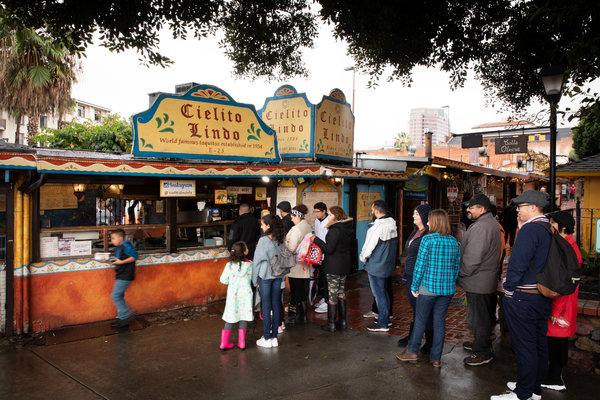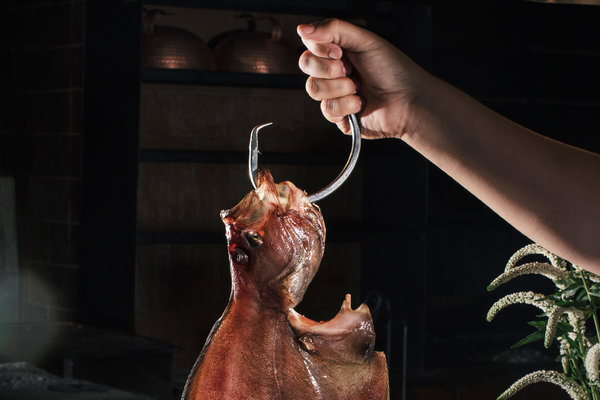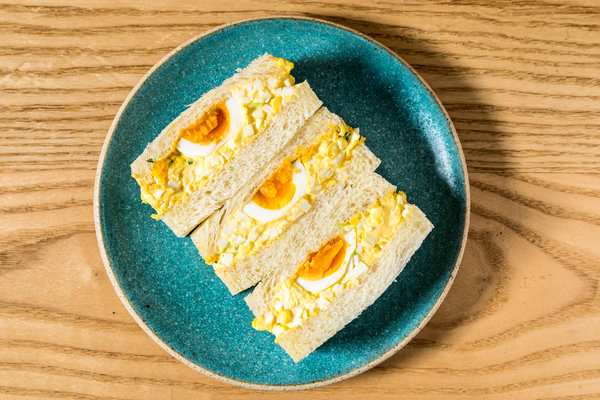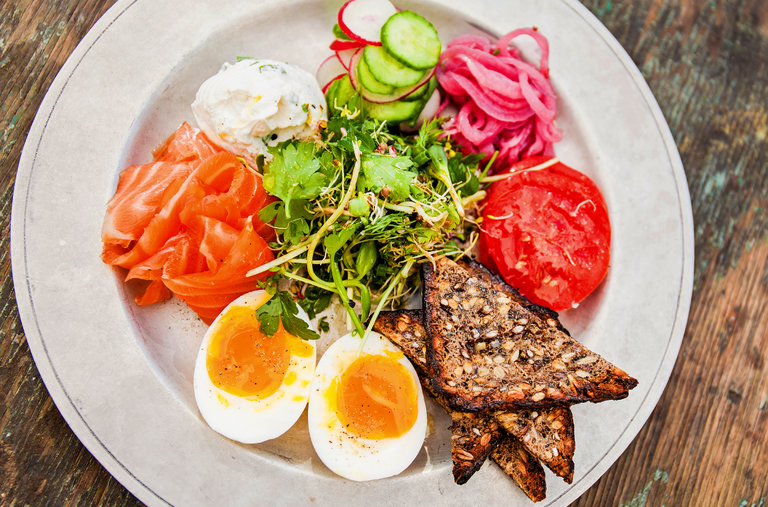LOS ANGELES — It was Friday night in Cypress Park, and King Taco glowed with neon. Inside, teenagers in sweatshirts and shiny puffer coats tipped cups of salsa on beef-tongue tacos. Cooks hustled, calling out orders in Spanish.
Angelenos don’t usually know where I live if I rattle off the cross streets, but add just one detail — that the first location of King Taco is close by — and many of them can drop a pin on a map. A few have reminded me that Raul Martinez Sr., who started the California chain in 1974, drove one of the city’s first food trucks, altering the course of culinary history in Los Angeles with little more than an old ice cream van and a stack of tortillas.
The first King Taco is a cramped, vaguely peach-colored building at the end of a residential street. The windows are covered up with posters of chimichangas and champurrado. The grout is stained. It’s nothing fancy. But like many old restaurants in Los Angeles, it’s a landmark in the city’s consciousness.
As a new critic in town, I knew I had to start by paying respects to elders like this one — the steakhouses and the taco stands, the diners and the burger joints that have endured and collectively defined the city, as new contenders have come and gone.
The restaurant business is punishing, and Los Angeles is often misunderstood by outsiders as a city without history. These places defy the stereotypes, and draw diners of all ages and backgrounds.
I appealed to Angelenos for their favorites then set out to learn more. Slowly, I worked my way through a map of 30 or so restaurants, connected by a squiggly, grease-smeared line that traced a history, stretching back in some cases more than a century.
On the edge of Chinatown, I kicked around sawdust inside Philippe the Original while waiting for a couple of French-dips — the sandwiches stuffed with thinly carved beef and lamb, the soft rolls drenched with salty brown pan-roasting juices.
Philippe’s was founded in 1908 and moved to its current location in the 1950s. The menu reflects the grizzled tastes of another era: I pulled the meat and elastic tendon from pickled pig’s feet, and marveled at hard-boiled pickled eggs, still tender, dyed purple with beet juice, smeared with nose-tingling hot mustard.
Just down the street, in the heart of old Los Angeles, I ate at Cielito Lindo, a small stand open since 1934 and largely responsible for the popularity of taquitos in the city. The tiny rolls full of shredded beef are fried in wide pans, then soaked in a thin avocado sauce while still hot. They were properly drenched, but remained delicately crunchy.
Locals and tourists stood in the sunshine, picking the taquitos up with their fingers, talking between bites.

The taquito stand Cielito Lindo and the surrounding market are a regular stop for both locals and tourists.CreditCoral Von Zumwalt for The New York Times
Dan Tana’s, the low-key celebrity hangout in West Hollywood, took my reservation over the phone. I sat in a slippery booth with a burly, well-built veal parm, saturated in red sauce, almost hidden beneath a shining layer of molten cheese, watching the well-dressed servers dress bowl after bowl of Caesar salad on a trolley in the middle of the room. (And I did my best to ignore Alfred Molina and Eric McCormack at the next table — even as they broke into song.)
When the weather turned cold and rainy, and the city got dark at 5 p.m., I fortified myself with spicy clam broth at Beverly Soon Tofu, a small restaurant with shiny redwood tables in a strip mall in Koreatown. Monica Lee, an immigrant from Seoul, opened her place in 1986. Originally on Beverly Boulevard, it was the first in the neighborhood to specialize in a menu of soondubu, or tofu stew.
She bought soy milk to make the tofu in-house, and gave diners several options to customize their bowls — to choose not only the general direction of their stew but also the level of its heat.
Ms. Lee, 65, buys the fresh, soft, wobbly tofu now, but still gets up early a few times a week to shop for produce. (She tried vegetable delivery, briefly, in 1987, but missed picking out the cabbage and spring onion herself.) The tofu is ghostly pale and delicate, but the stew comes out hot, bubbling vigorously and viciously, stained red with a chile paste that Ms. Lee makes herself.
While new restaurants in Los Angeles struggle to train and retain staff, the cooks at Beverly Soon Tofu have worked with Ms. Lee for decades, fermenting kimchi and frying kelp. “They speak broken Korean to me, I speak broken Spanish to them,” Ms. Lee said. “And this is how we work together.”
At the Tam O’Shanter, a Scottish-themed pub in Atwater Village, I lined up in front of Stevie Delgado for six ounces of prime rib with mashed potatoes and creamed spinach — a generously portioned plate lunch. The restaurant has been open since 1922, and Mr. Delgado has worked at its carving station, by the bar in the dining room, for the last 30 years. He filled my plate in an instant, ladling it with gravy.
Mr. Delgado slices five ounces of blush prime rib for sandwiches, and either six or 10 ounces for a plate. The scale, which doesn’t move from Mr. Delgado’s side, isn’t for him — I think he could cut precisely 10 ounces with his eyes closed. It’s for the occasional suspicious diner who doesn’t think Mr. Delgado is getting it right.
The Tam O’Shanter servers wear tartan skirts and wool hats, which can give the place the look of a fusty tourist attraction. But to dismiss it as such is to misunderstand the vital role it plays for regulars.
Though the Tam O’Shanter was a clubby hangout for Disney executives in the 1950s, the lunchtime crowd that now fills the kitschy pub is a more diverse representation of the city: elderly couples with their elbows locked together, immigrant families and groups of young women, clinking their pints of beer. They’re drawn in not just by the restaurant’s unfussy comfort food, but by its consistency and warmth.
I enjoyed the steakhouse chain Lawry’s the Prime Rib, run by the same company as the Tam O’Shanter, even more after I learned that the Los Angeles chef Roy Choi has been going to the location on La Cienega Boulevard since he was about 5.
Mr. Choi’s father worked there in the 1960s, as a dishwasher and busboy, and the restaurant later became a place to celebrate important family occasions, like birthdays and graduations.
“It’s been a part of my life before I was born,” Mr. Choi said. “I think the moment my father could afford it, and I could chew, he took us.” Mr. Choi, a founder of Kogi BBQ who also wrote the cookbook “L.A. Son,” compared Lawry’s old-fashioned banquet-hall environment to “an American dim sum parlor.”
It’s never just about the food. Culinary institutions often have the kind of professional, experienced employees that new restaurants can only dream about: Bartenders who can read the slightest changes in body language. Unflappable servers.
At the U-shaped counter inside the Apple Pan, a sparse diner in West Los Angeles, the smoky burgers in squishy buns are wrapped in paper and unceremoniously plopped onto the counter by a highly efficient staff with total command over the lunch rush.
And when the server in a pressed red jacket at the Musso & Frank Grill learned that my dining companion was pregnant, he was attentive but not patronizing. Witty, but not inappropriate. This shouldn’t be so remarkable, but it is.
Musso’s, in Hollywood, maintains an impossibly charming dining room with faded wallpaper and warmly lit burgundy booths. Under the influence of a bracingly cold martini, I wondered if its cold jellied beef consommé, eaten with a spoon — the kind of thing you’d feed a sickly Victorian schoolchild — stood a chance at a comeback. Maybe not, but the cocktails and steaks are unfailing. The wedge salads are dignified.
For hot pastrami, I headed to Langer’s, in Westlake, and to Canter’s, a 24-hour deli that opened in a former theater in Fairfax in 1953.
On return visits to Canter’s for sandwiches and matzo-ball soup — and simply to be in its bustling dining room, among its regulars — I found it particularly fulfilling to check in on the pastry case, crammed with sweets. I noticed how the word “banana,” written in bright yellow frosting on the chocolate-iced loaf cake, changed drastically depending on who had decorated it.
The longer my tour of classics went on, the less dutiful it felt. There was nothing campy or insincere about the pleasures of old Los Angeles. Not even its fast food.
Mr. Martinez, who founded King Taco, went on to build a small empire of Mexican restaurants in Southern California, and the taco al pastor that he first peddled from a truck — a style of taco he helped popularize in Los Angeles before it became a staple — is still a reliably good snack in what has become a neighborhood hub.
The tortillas are hot and flexible, the meat crisp at the edges, pleasingly greasy and deeply seasoned. The salsas are one-note, but sing with power.
Though the tables were all full, a few people scooted down, pushing their bags and coats to the side, making room, gesturing for me to sit. To join them. To eat by their side. They might as well have said it out loud: Welcome to Los Angeles.











